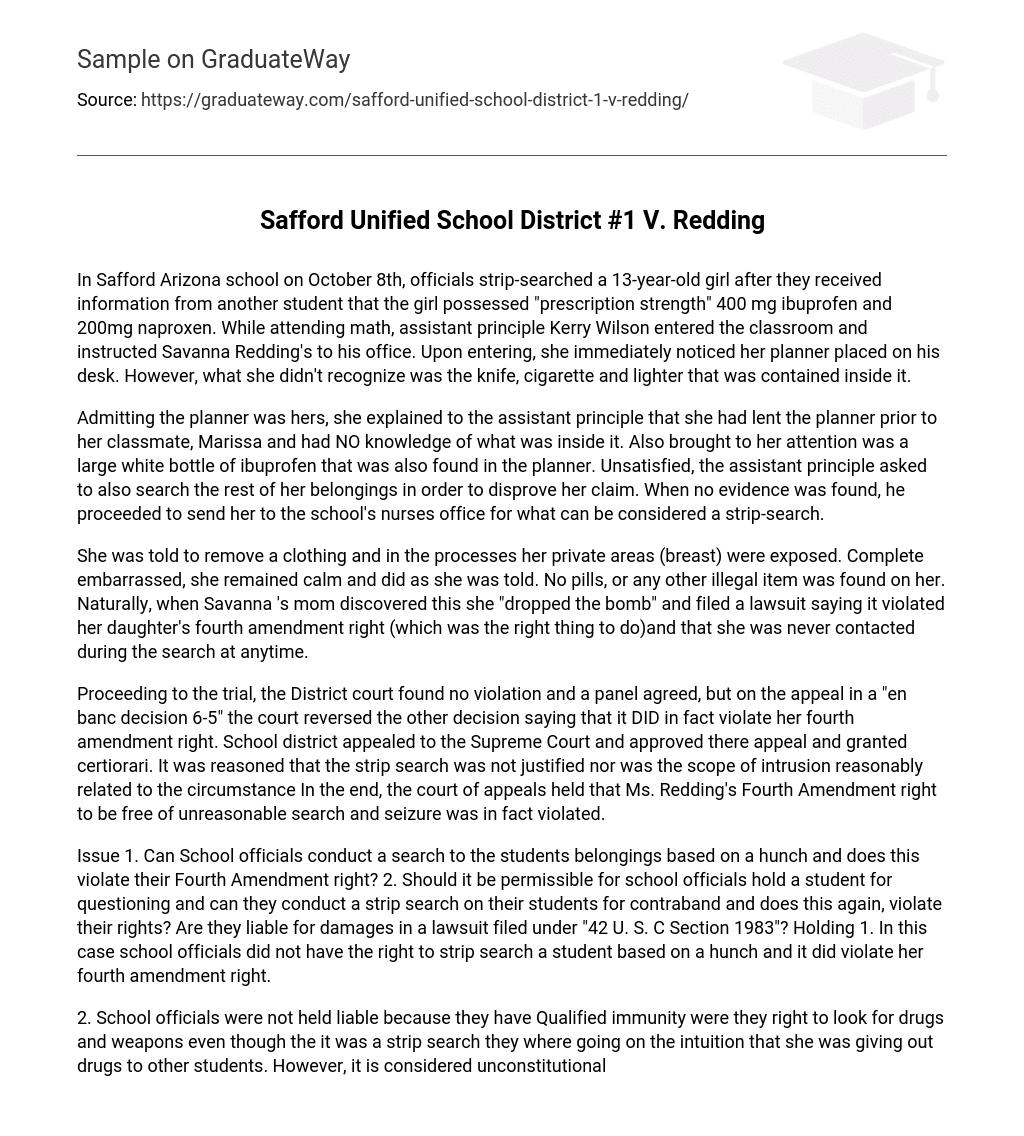Officials at Safford Arizona school conducted a strip search on 13-year-old Savanna Redding on October 8th. The search was prompted by another student’s report that she had “prescription strength” 400 mg ibuprofen and 200mg naproxen with her. Assistant principle Kerry Wilson summoned Savanna to his office during her math class. Upon arrival, she observed her planner on his desk but was unaware of the concealed knife, cigarette, and lighter within.
The student admitted that the planner belonged to her and clarified to the assistant principal that she had loaned it to Marissa, a classmate, unaware of its contents. Additionally, a large white ibuprofen bottle was discovered in the planner. Despite these explanations, the assistant principal remained dissatisfied and requested to inspect the student’s other belongings as evidence contradicting her statement. When no proof was found, the assistant principal directed her to visit the nurse’s office at school for a strip-search.
During the search, she was requested to remove an article of clothing, resulting in her private areas (breasts) being exposed. Although feeling embarrassed, she stayed composed and followed the instructions. No illegal items or illicit substances were discovered on her. Upon being informed of this event, Savanna’s mother promptly initiated legal proceedings, asserting that it violated her daughter’s Fourth Amendment rights (which was the correct course of action). She also stressed that she had not been notified during the search.
The District court and a panel agreed during the trial that there was no violation. However, an “en banc decision 6-5” on appeal reversed this ruling and found that it did infringe upon her fourth amendment right. The School district then appealed to the Supreme Court, which accepted their appeal and granted certiorari. This decision was based on the lack of justification for the strip search and its excessive intrusion given the circumstances. Ultimately, the court of appeals concluded that Ms. Redding’s Fourth Amendment right to be free from unreasonable search and seizure had been violated.
Can school officials search student belongings based on suspicion without violating their Fourth Amendment rights? Should they have the authority to detain and strip search students for prohibited items, and would this be a violation of their rights? Are school officials held responsible for compensatory damages in a lawsuit filed under “42 U.S.C Section 1983”? However, in this particular situation, the student’s Fourth Amendment rights were violated by school officials who conducted a strip search solely on suspicion.
School officials were protected from legal liability due to their Qualified immunity; however, the strip search they conducted on Savanna was deemed unconstitutional. While it was warranted for them to search for drugs and weapons based on suspicion of her distributing drugs to fellow students, administrators lack the power to carry out this form of search. Justice Souter, Chief Justice Roberts, Justices Scalia, Kennedy, Breyer, Alito, Stevens, and Ginsburg all agreed that the strip search violated Savanna’s Fourth Amendment rights.
Despite their suspicions, school officials did not have the authority to conduct a strip search on her. Nevertheless, they are protected by qualified immunity because they intended to safeguard other students and act appropriately. It is important to note that searches carried out by school officials in order to find prohibited items must be relevant to the objective of the search and should not be excessively invasive. Factors such as the age, gender, and offense committed by the student should be considered. Justice Souter’s Concurring Opinion stated that Savanna’s Fourth Amendment rights were violated as there was no reasonable belief that she had drugs hidden in her bra and underwear. Therefore, there was no justification for conducting the search. The judge concluded that although school officials were not held accountable and could claim qualified immunity due to their sole aim of preventing drug distribution within the premises of the school, Justice Ginsburg also expressed a concurring opinion.
The school administrators were considered partially immune to prosecution by the majority, but there was disagreement regarding judicial interference in school safety matters. Justice Thomas and several other judges dissented, asserting that the fourth amendment safeguards against unreasonable search and seizures.
According to the text, students have the fourth amendment right on school property. However, this right is limited due to the responsibility of schools and their officials in ensuring student safety. Thomas partially agreed with this judgment but also dissented from it. He supported school administrators’ immunity to some extent but opposed judicial interference in decisions made by administrators for the sake of maintaining school safety.





